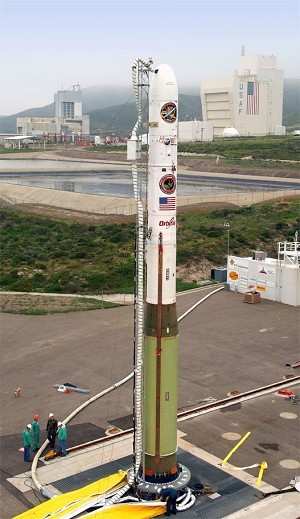Sun, Aug 02, 2015
Minotaur IV Will Launch SensorSat Space Vehicle To Orbit
The U.S. Air Force’s Operationally Responsive Space (ORS) Office has awarded a contract worth $23.6 million to Orbital ATL to launch the ORS-5 SensorSat spacecraft in mid-2017, using a rocket from the company’s Minotaur Launch Vehicle Family.

The ORS-5 mission will employ an Orbital ATK Minotaur IV rocket lifting off from Launch Complex-46, operated by Space Florida at Cape Canaveral Air Force Station. This will be the first time a Minotaur vehicle will have flown from this range.
“Launching from the Cape adds another capability to our program and brings us to four ranges from which Minotaur can launch,” said Rich Straka, Vice President and General Manager of Orbital ATK’s Launch Vehicles Division. “This flexibility and multiple vehicle configurations enables Minotaur launch vehicles to be tailored to meet mission requirements while offering the lowest cost flight-proven launch vehicles available to the U.S. government.”
This Minotaur IV rocket uses retired Intercontinental Ballistic Missile (ICBM) Peacekeeper boosters for the first three stages and Orbital ATK Orion 38 solid rocket motors for the upper stages. Orbital ATK integrates the vehicle using flight-proven avionics, structures, software and other components that are common among Orbital ATK’s space launch vehicles.
Using a launch vehicle comprised of solid rocket motors requires minimal pad infrastructure, which helps lower mission costs. The team will integrate the final launch vehicle using the Orbital ATK team at the Cape with a team comprised of employees from both Orbital and ATK heritage companies.
“This is a prime example of where the synergies from the Orbital ATK merger are providing real benefits to our customers, by being able to deploy one launch team that possesses expertise from critical propulsion and avionics subsystems, to the full systems engineering understanding of the vehicle,” said Scott Lehr, President of Orbital ATK’s Flight Systems Group.
The award was won as a competitive commercial launch contract for the Operationally Responsive Space Office and will be licensed by the FAA.
(Image from file)
More News
Aero Linx: Model Aeronautical Association of Australia MAAA clubs are about fun flying, camaraderie and community. For over 75 years, the MAAA has been Australia’s largest fl>[...]
Touchdown Zone Lighting Two rows of transverse light bars located symmetrically about the runway centerline normally at 100 foot intervals. The basic system extends 3,000 feet alon>[...]
“Discovery and innovation are central to our mission at Virgin Galactic. We’re excited to build on our successful record of facilitating scientific experiments in subor>[...]
How To Get A Story On Aero-TV News/Feature Programming How do I submit a story idea or lead to Aero-TV? If you would like to submit a story idea or lead, please contact Jim Campbel>[...]
Student Pilot Reported That During Rotation, “All Of A Sudden The Back Of The Plane Kicked To The Right..." Analysis: The student pilot reported that during rotation, “>[...]
 ANN's Daily Aero-Linx (05.02.24)
ANN's Daily Aero-Linx (05.02.24) ANN's Daily Aero-Term (05.02.24): Touchdown Zone Lighting
ANN's Daily Aero-Term (05.02.24): Touchdown Zone Lighting Aero-News: Quote of the Day (05.02.24)
Aero-News: Quote of the Day (05.02.24) ANN FAQ: Contributing To Aero-TV
ANN FAQ: Contributing To Aero-TV NTSB Final Report: Cirrus Design Corp SR20
NTSB Final Report: Cirrus Design Corp SR20



